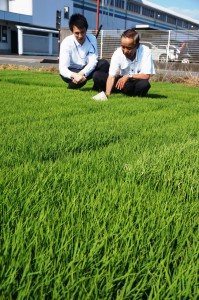
Katsunori Ogawa (left), head of Sunami Eino Kumiai, checks growth of young rice plants in Mizuho, Gifu Prefecture, with an official of JA Gifu in late May
Hayato Niki, Chikuma Kume
As agricultural co-operatives nationwide encourage their member farms to expand their acreage of rice for feed, farms in some regions are doubling the production compared with the previous year. However, in order to meet the JA group’s goal of producing 600,000 tons of rice for feed in a year, member farms need to increase their yield by 3.3 times from a year before. It is indispensable for the farms to conduct further acreage shift from table rice to rice for feed, so as to better balance supply and demand in the harvest season.
Producing rice for feed “is definitely more profitable than (cultivating) table rice,” says Katsunori Ogawa, head of Sunami Eino Kumiai, an agricultural union in Mizuho, Gifu Prefecture. The union, which operates 137 hectares of farmland, had not been producing rice for feed until last year, but this year it switched 32 hectares out of 106 hectares of its rice fields to cultivation of rice for feed.
The union cultivates a high-yield variety Mitsuhikari. JA Gifu, an agricultural co-op in Gifu, estimates that the union will be able to harvest at least 10 hyo (a hyo is equivalent to 60kg of rice) per 10 ares, roughly 25 percent more than the average yield in the district. Ogawa says the union will be able to receive JPY105,000 per 10 ares of government subsidies for rice for feed, the maximum amount paid according to the yield.
Since last summer, JA Gifu has been proposing cultivation of rice for feed to some 200 major agricultural groups in the district, including Sunami Eino Kumiai. “We have explained to them that if they shift half of their crops to rice for feed, they can obtain subsidies for rice for feed and also benefit from a rise in prices of table rice if the prices recover,” said a JA Gifu official.
As a result of such efforts, JA Gifu predicts it will obtain about 2,900 tons of shipments of rice for feed this year, nearly double the amount marked last year.
The JA group sets a target harvest for rice for feed in each prefecture. The target for Gifu is 11,800 tons, and the yield under the current situation is predicted to reach nearly 80 percent of the target amount. The JA group’s Gifu prefectural union said it will continue asking primary JAs to encourage member farms’ switching from table rice, so that they can get as close to the target as possible.
An increase in production of rice for feed is also prominent in Aomori Prefecture. According to the Aomori division of the National Federation of Agricultural Co-operative Associations (JA Zen-Noh), the total production of rice for feed in the prefecture this year is likely to reach 35,000 tons, up from 16,000 tons marked last year, and largely exceeding the prefecture’s target of 27,800 tons.
In order to facilitate production of rice for feed, local authorities offer grants of up to JPY10,000 per 10 ares even to those who produce table rice varieties and market them as rice for feed. As table rice prices remain sluggish, more farmers were convinced that switching to production of rice for feed would ensure a stable income.
Tochigi Prefecture is also likely to meet its target, according to the agriculture ministry’s estimate as of the end of April. In the district under the jurisdiction of JA Shimotsuke, an agricultural co-op in the city of Tochigi, the total yield of rice for feed is predicted to amount to some 6,500 tons this year, up from some 3,000 tons a year before, roughly the same amount as the yield for table rice.
The agricultural co-op has explained at community meetings and negotiations for shipment contracts with farmers that rice prices will never recover if supply and demand remain unbalanced. “Farmers who have been taking a wait-and-see attitude learned a lesson from the sluggish trend in rice prices and decided to switch to cultivation of rice for feed,” said a JA Shimotsuke official.
As for Ibaraki Prefecture, the acreage of rice for feed is expected to be 1.6 times more than the initial target of 900 hectares. As the deadline nears for farmers to submit their farming plans to agricultural authorities, officials of JA Kitatsukuba, a farm co-op in Chikusei, Ibaraki, plans to visit those who cultivate table rice other than the Koshihikari brand in June. They said they hope to persuade more farmers to switch to production of rice for feed by stressing again the significance of balancing supply and demand.
(May 29, 2015)

